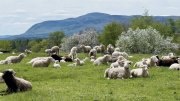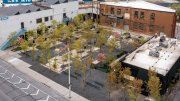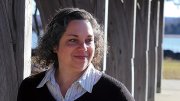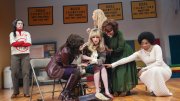Lila’s Mountain Farm sits in a scenic corner of western Massachusetts, on rolling pastures with sweeping views of the Berkshires. In early February, during lambing season, snowstorms and a cold snap have turned the fields into icy white plateaus. Winds whip and roar outside the sheepfold where 25 ewes—those caring for newborns and others about to give birth—are hunkered down in the hay.
Shepherdess Mary Berle ’87, Ed.M.’90, and her assistant Julie Rose Clapton are there, too, tending to a fragile lamb. The birth was fraught and at 4 a.m. they’d been glad to get him out alive. His twin didn’t make it.
Clapton bottle-feeds the lamb in her lap beside his mother. “We’ve kept the pair close together,” Berle says, “because she’s a good, caring mother, and bonded, and he’s trying hard. We intervene as little as possible to support their success.”
The atmosphere is peaceful. No agitated baaing or commotion, no jockeying for food or attention. Two of Berle’s giant white sheepdogs are in the mix, too, watching over the group. Some 250 sheep, the rest of the flock, are in an upper pasture, where six more dogs stand like sentries on the periphery, protecting them from coyotes and eagles. That the dogs, the sheep, and the people join forces in an interdependent system, Berle finds compelling. “The work is not about directing or leading,” she says. “It’s about having a vision—but being in concert.” People talk about “orchestras being the highest form of human civilization and all the collaboration and coordination that goes into playing well. I think the farm—being with the flock, working with the dogs, bringing in and listening to young people like Julie—is very much like that.”
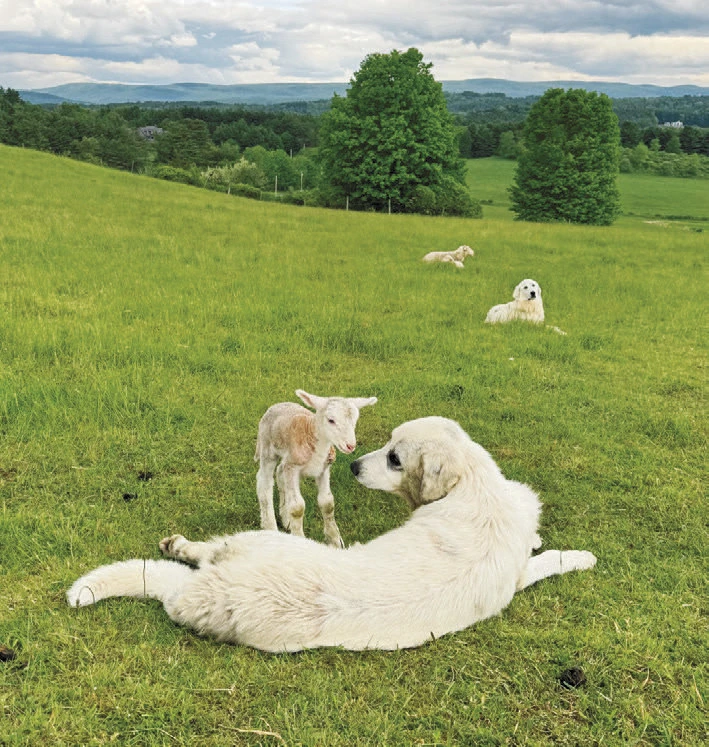
Before she took over operations from her mother Lila Berle in 2020, Berle had a successful career in education. She spent nine years at the Cambridge-based TERC (Technical Research Education Centers), including as a curriculum developer, before joining the Berkshire Hills Regional School District for 13 years, working as a mathematics coordinator and a third-grade classroom teacher (when she founded a unicycle club and taught 200 children how to ride) and ultimately as the principal of the Muddy Brook Regional Elementary School, in Great Barrington. She was the chief educator at the Norman Rockwell Museum in nearby Stockbridge, Massachusetts, when her aging mother (who founded the farm in 1991) called to say: “I need you to start with the animals tomorrow.”
It was a sudden but welcome request. Berle’s three children were out of the house, and she felt up to the challenge of one last really big project. It meant working for herself, “doing something productive, and being outside,” she says. “And I’ve always loved animals. Before getting sidetracked into education, I had thought about being a vet.” Within two days she reported for duty and for the next 18 months toggled between her museum job and learning to manage the farm.
There’s plenty of overlap, it turns out, between that and working in a school. For her, teaching meant “creating an experience where I was listening to the kids and we were working together to develop the plan of what we were learning,” she says. “It’s the same here, being fully present, connected to the animals.” At the farm, as at the school, her role “is to support everyone in the system and make sure that everyone has a good, calm, productive day. It’s so parallel,” she laughs, “with the sheep a little easier to please.”
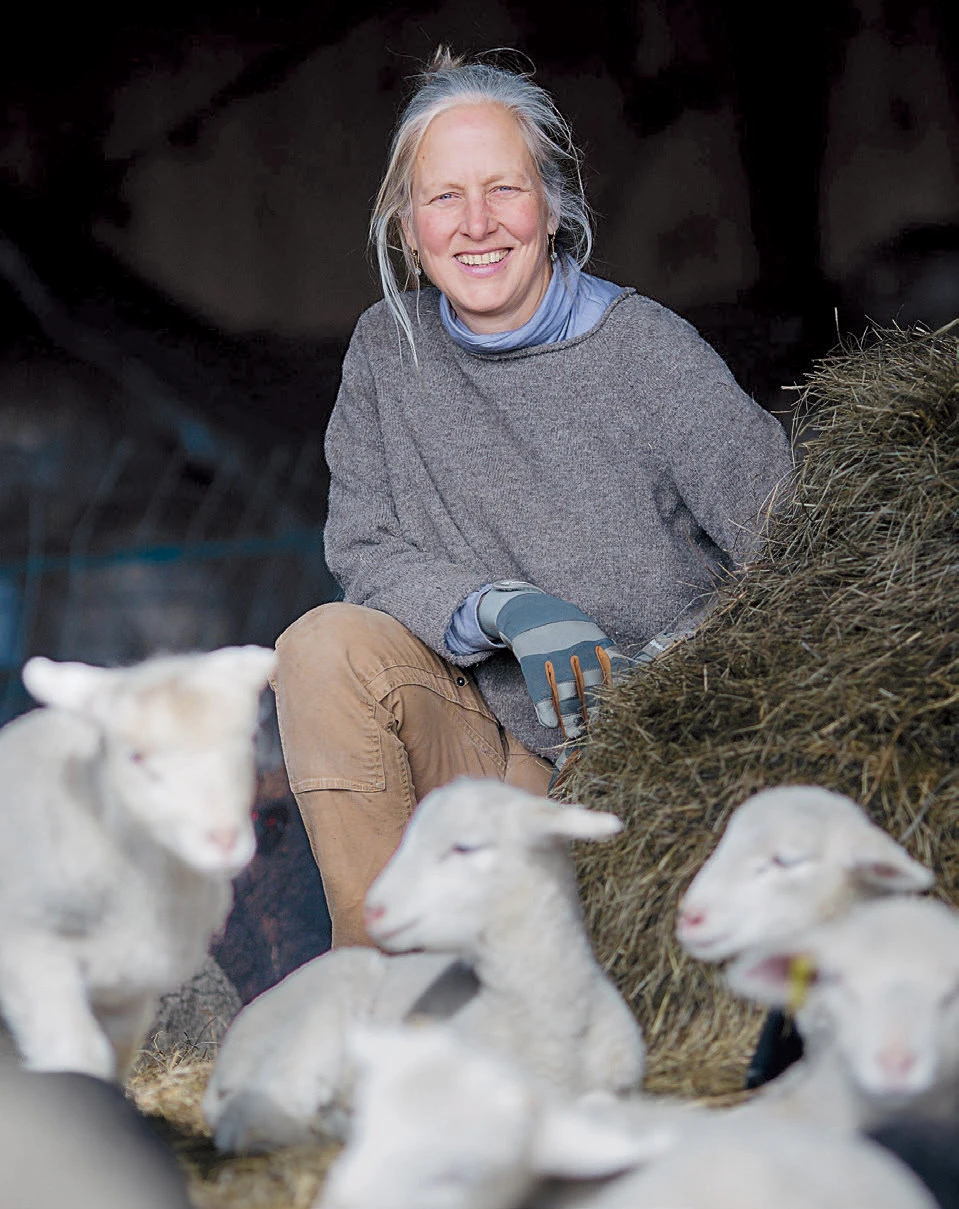
Caring for the flock—along with the dogs and a herd of 15 Highlander cows—was not entirely new. Berle grew up in Stockbridge on a gentleman’s farm, helping with chores, along with her three siblings, including brothers Dolf Berle ’85, M.B.A. ’91, and Robert Berle ’92. (The family’s Harvard connections run deep. Among them: Berle’s daughter is Louisa Carman ’16; her father, Peter A.A. Berle ’58, LL.B. ’64, was a lawyer who served as a member of the New York State Assembly and a president of the National Audubon Society; and her grandfather, Adolf Augustus Berle, A.B. 1913, A.M. 1914, LL.B. 1916, was part of President Franklin D. Roosevelt’s “brain trust,” serving as assistant secretary of state and ambassador to Brazil.)
Lila’s Mountain Farm, which straddles Egremont, Alford, and Great Barrington, was in full swing by 2003 when Mary Berle moved back to her hometown as a single mother with her young children. She helped her parents, and they all pitched in with the animals. Berle’s sister, Beatrice Berle, had become an organic farmer in Hoosick Falls, New York, and the sisters’ aunt, Alice Field, was running Foxhill Farm, a small-scale, high-quality wool operation in Lee, Massachusetts.
These women, along with Lila Berle, now 88, have been invaluable. Husbandry, haymaking, soil enrichment, skirting fleeces—Berle has faced a steep learning curve. Lessons came, too, from her time at Harvard. She was the captain of the bike racing team, concentrated in visual and environmental studies, and took design and ecology classes, including an influential freshman seminar at the Harvard Forest. Photography was, and is, her chosen art form (see her work, for sale, on the farm’s social media channels), and her art courses instilled an openness, an ability to analyze facets of any issue, of any problem, and find creative solutions. “Harvard taught bravery,” she says now.
She still thinks about all she learned from Orchard professor in the history of landscape development John R. Stilgoe and his course, Built North American Environment. “He’d have a field day at the farm,” she adds, because so many stories “of New England development, from the history of the barns and houses, from 1790 to 1960, and the changes to the land, including recent suburban development, are represented here.”
Much has changed even since her mother bought the former dairy farm property and brought in 40 sheep to graze on the land. Financing, for one, is more precarious. The place has remained a rare regional dual-purpose (meat and wool) operation because her mother was willing and able to lose money every year. Berle can’t do that. The 420-acre farm is close to sustaining itself, she says, “but it will have an expiration date unless I figure this out.”
Creativity and art offer one route to keeping it viable. The evolving business plan, Berle says, is to build more relationships with “a variety of makers and artists doing unique things with the wool and have it come back to the farm with our label on it, with a highly visible, transparent supply chain.” The flock includes a mix of Dorset, Romney, and Rambouillet breeds, which have been bred for a “clean face, clean legs, and fine wool” known among knitters as soft, strong, and bouncy. It knits almost like felt. Whereas her mother relied mostly on meat sales for revenue, selling the wool wholesale to a Maine farmer (who made blankets and sweaters) in the last several years leading up to 2020, Berle is flipping that model. She is focused on developing the wool supply to clothe people and produce other goods “in ethically sourced ways in a sustainable supply chain.”
The sheep are sheared on site and produce about 800 pounds of premium wool (and maybe 300 pounds of belly wool) a year. The worker-owned Green Mountain Spinnery in Putney, Vermont, washes, cards, and spins it into yarn. The farm sells skeins to knitting shops and individual knitters, while the larger cones of wool go to commercial weavers and machine-knitting companies. Muriel’s of Vermont, a natural-fibers clothing venture run by a mother-and-son team, produces beautiful sweaters from the farm’s wool, for example, priced from $150 to $350. Berle can sell as many sweaters as they make, through farmers’ markets, holiday fairs, and at the farm itself. This year, she launched the farm’s own knitwear collection, which includes a sweater-and-hat set and a hooded scarf crafted in conjunction with local designer Julia Baier. Berle has formed a new partnership with Bedfellows Blankets, in Shelburne Falls, Massachusetts, a maker of artisan blankets using antique industrial looms. Clapton plays a role in developing the business, too. A 2023 Rhode Island School of Design graduate and award-winning fiber-based artist in Brooklyn, New York, she has worked on the farm, learning about traditional modes of fiber production; she created a museum-quality cape, Magdalene, from the sheep’s wool and is working on other pieces. Separately, Berle is using the 200 to 300 pounds of “waste wool,” sheared from the animals’ bellies, to produce fertilizer pellets for sale by mixing it with manure. These can replace peat moss and chemical fertilizers: when mixed with soil, the pellets hold moisture, like peat moss, and slowly release it, along with the manure and other organic matter. The pellets were developed in conjunction with the Western Mass Fibershed, and Berle has helped build a supply chain for other sheep farmers to contribute their waste wool through the collective.
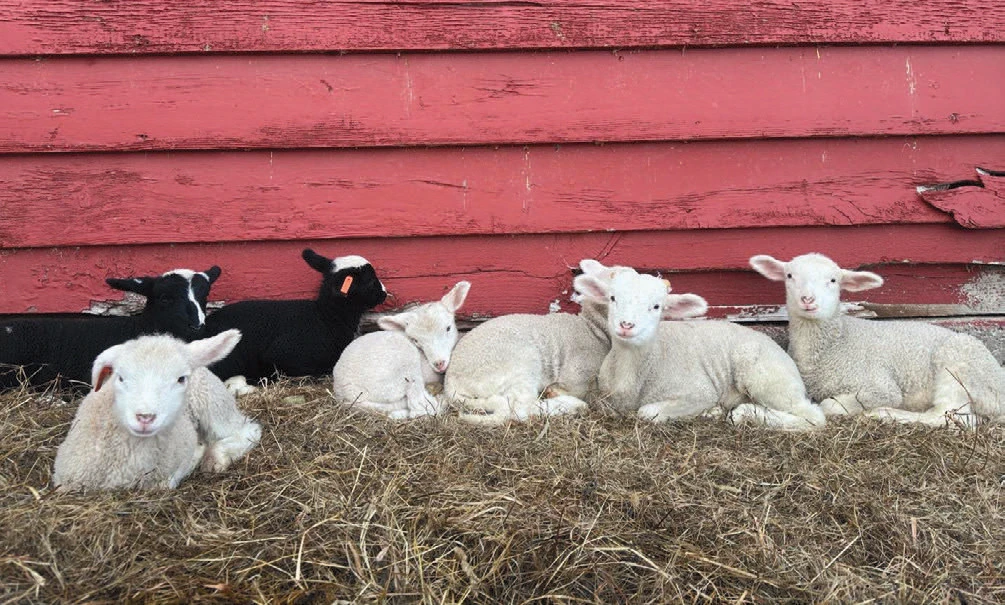
The farm’s pellets also enrich a six-acre “field of dreams” where Berle grows thousands of dahlias, peonies, and other flowers. They will be sold to designers and through this year’s debuting peony community supported agriculture (CSA) farm. The hope is that ultimately the flower-sale proceeds will cover a substantial portion of the farm’s costs. “So, I’m excited that we grow food, fiber, and flowers. It all becomes a celebration of fiber and flock, and an honoring of my mother, and of this matriarchy,” she says, floating an arm toward the serene scene of ewes in the sheepfold. “It connects so many things about the spiritual development, and business, of the place.”
Berle is soft-spoken and persistent. She’s also “willing to suffer for the greater good,” she says, with a laugh, having been reared “in a family where the goal was never to be comfortable, physically or intellectually.” She knows that her vision faces profound challenges, beyond the immediate economic concerns. Climate change. Encroaching development. Human thoughtlessness.
To protect the flock from the sun, she’s created shelters and planted more than 300 trees. Mitigating flooding is a continuing project, although a summer drought in 2024 meant relying on hay-feed (all of which is grown on site), rather than grass, for the sheep. U.S. Department of Agriculture scientists have indicated she must construct windbreaks in the flower fields, or crops will fail. “Climate variability and extreme weather is a defining factor,” she says. “We don’t know if it will be too wet, dry, cold, warm, windy, and we have to be ready no matter what happens.” Berle has worked to ensure the hay’s high quality; it affects the flock’s health and its wool. Berle has also worked hard on timing cultivation, wrapping the bales, and measuring moisture levels so that the stalks ferment properly. If she gets it wrong, everything turns to “mush and mold.” “I have to really know what I don’t know,” she says, “and ask myself: Which parts of this work do I like, and when do I need to bring in support?”
Managing interfering humans is one task she’d delegate if she could. Because three roads cut through the farm property, dog walkers, joggers, and drivers often stop to engage her sheepdogs, wanting to make videos of them rushing the fence. “Our only losses to coyotes last year were related to humans distracting the dogs,” she explains. Although the farm’s land is protected through agricultural easements, houses have been built on abutting parcels, shifting the local dynamic so that, she says, “we really need to educate people that this is not a petting zoo.”
All that aside, Berle is deeply inspired by the young people engaged with the farm, like Clapton, her niece Eliza, and Cyrus Brooks, who co-owns Muriel’s of Vermont. In many ways, Berle is still the resolute teacher, taking heart in their passions. They, and young farmers of the region, are facing the effects of climate change with integrity and active purpose, supporting the mission of her farm and others throughout the region. That kind of commitment helped Berle sell $10,000 worth of sweaters last year. It’s the reason Clapton traveled from Brooklyn again in February to help during lambing season—which produced more than 100 healthy babies.
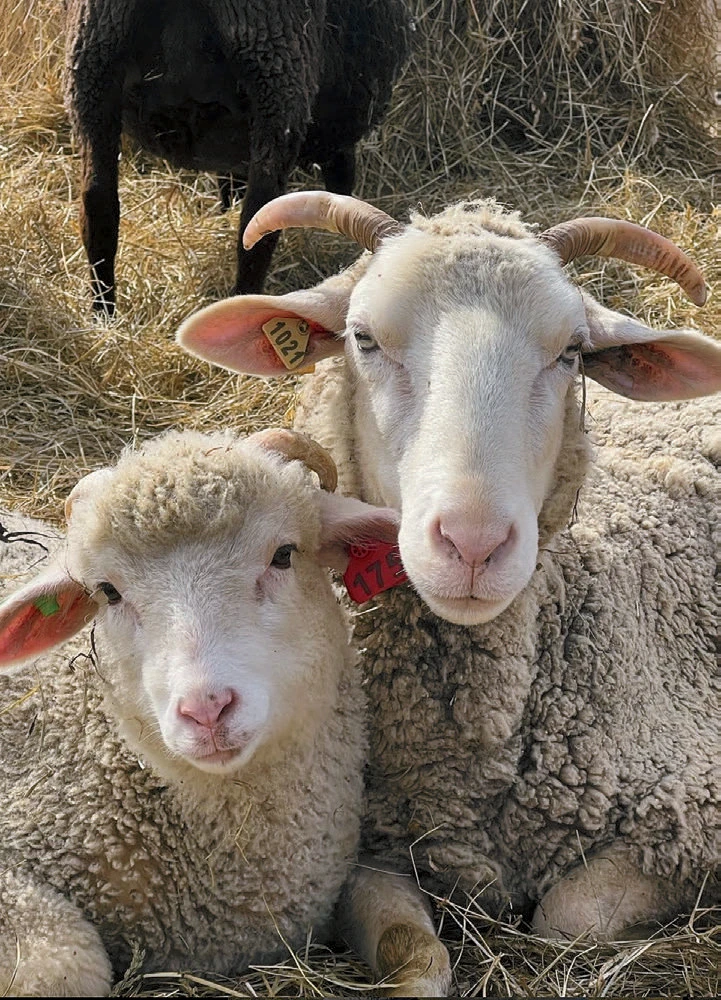
The weak newborn lamb they bottle-fed for 24 hours had, by that afternoon, finally latched onto his mother. “If that ewe did not feel good about us helping, if she did not trust me as the shepherdess, she would not have let us help her,” Berle says. “And I love that part of this work, when you’re in relationship to the animals and teaming together.” Leaving the pair to nestle in and rest, Berle and Clapton crunch up the ice-crusted hill in crampons, defying temperatures in the teens and raging winds, to check on the rest of the flock. From 20 feet away they monitor one ewe giving birth. The lamb’s nose and front hooves appear first, close together, “as if it were diving into the world,” Clapton notes. They agree the ewe is doing well, so no need to get involved. They discuss when it’s best to approach and towel off the baby and when to usher the pair down to the warmer shed. The key is to wait until they have bonded.
Berle considers herself a bridge—for the sheep and the dogs who protect them, for the young people serious about the planet’s ecological health, for consumers seeking sustainable natural goods made to last. Her own children have been supportive, if a little wary. “They think I’m a little nuts. My son Tommy will sometimes say, ‘I just want you to have a good chapter, Mom. And is it really worth all this work?’” She laughs but slowly nods. “Yes. It actually is. To be almost 60 and this fully engaged in life, and have these connections, this opportunity, this agency—is a dream.”
